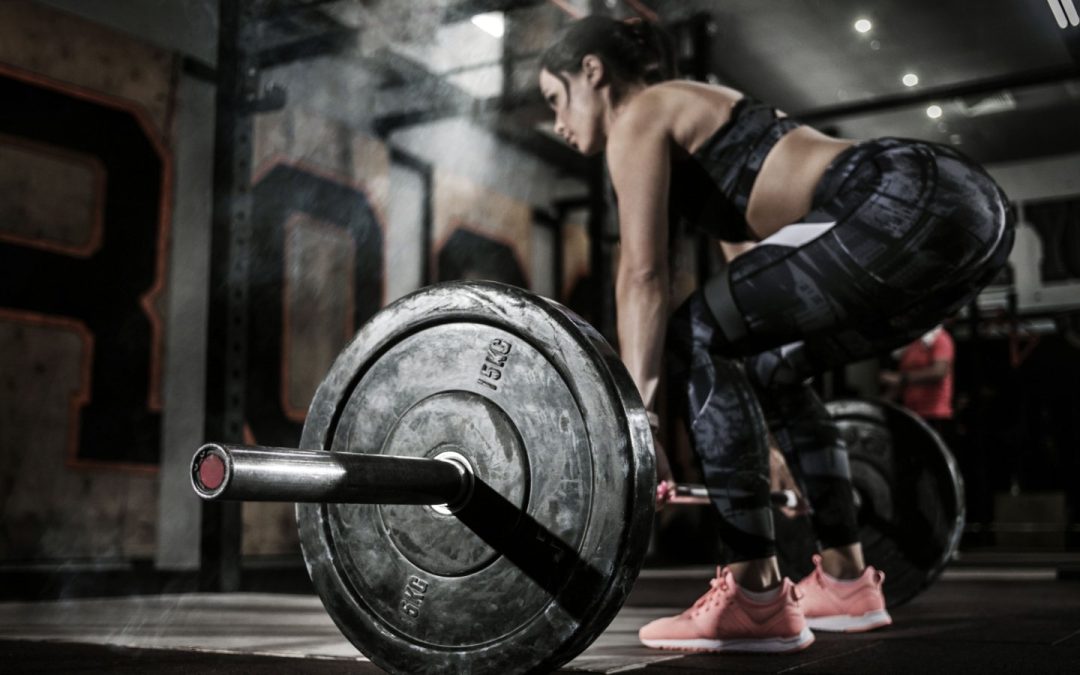There aren’t too many “one-lift wonders” that can make you epic by delivering a ton of benefits in a single set, but the deadlift is one of them. The conventional deadlift gives you the potential to lift a lot of weight, get jacked, and brag about your massive deadlift PRs (if that’s something you’re in to).
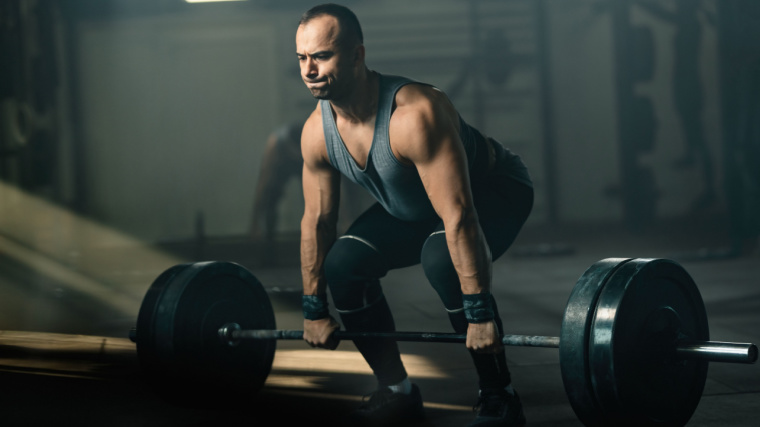
However, if done improperly, the deadlift can lead to frustration or even injury. Neither of those results are good for your long-term performance, let alone your spinal health, so it’s time to go over the key components of proper deadlift form. Here’s what to do and when to do it for a stronger, safer deadlift.
Perfect Your Deadlift Form
Deadlift Setup Tips
A strong and efficient deadlift begins before the weight even leaves the ground. Here’s how to make the most from each individual repetition.
Take Time to Set Your Stance
The first step in perfecting your deadlift form is to approach the bar and set your stance. For a typical conventional deadlift stance, you want your feet relatively close together, about shoulder-width. You can make slight adjustments to be able to reach the bar and pull upright while keeping good positions at your shoulders, through your back, and into your hips.
Position the barbell directly over the middle of your feet, roughly where your arches are. Your shins should be close to the bar, but not touching it. You shouldn’t need to roll the bar toward you or away from you before beginning the repetition, it should be in a good spot from the start.
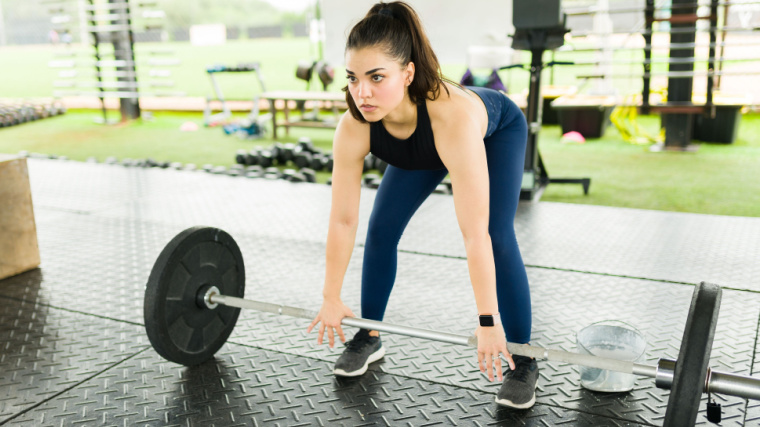
If the bar is in front of your toes, it will be too far from your centerline and you’ll have poor leverage to pull the weight. If it’s too close to your ankles, the bar won’t be able to follow a powerful, vertical path because your shins and knees will be in the way.
Point your toes straight ahead and keep your feet flat on the ground as you bend down to grip the bar.
Choose the Right Grip
Your grip is a crucial part of the deadlift as it helps control the weight and generate the force you need. Without a stable grip, you can say bye-bye to most of your motor unit recruitment because your grip is the place where power transfers from your body to the weight.
There are four grip variations you can potentially use, depending on your experience and goals: the double-overhand grip, the mixed grip, the hook grip, and the double-overhand with lifting straps.
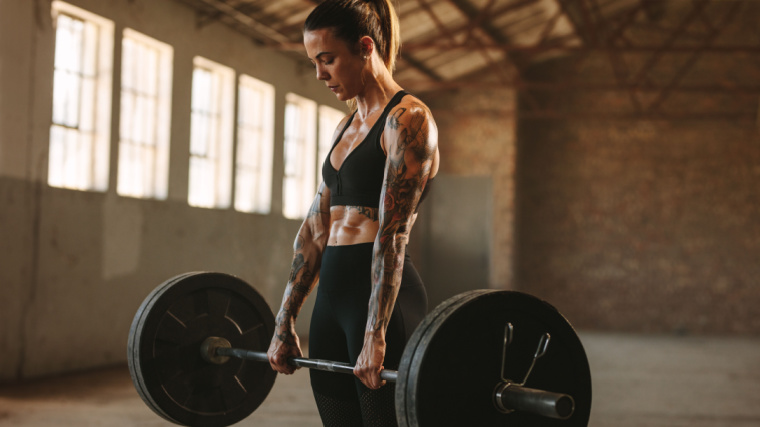
The double-overhand grip involves both hands gripping the barbell with your palms facing down. This is a good grip for beginners, as it allows for even distribution of weight across your body and it helps to build grip strength.
This is also the most common grip for most lifters. If you can use the double-overhand grip, use it. It doesn’t have any significant injury risks and it keeps the weight of the bar evenly distributed. However, some people might “outgrow” the double-overhand grip as they progress in strength. Then it might be time to use a mixed grip.
The mixed grip involves gripping the barbell with one palm facing down and the other palm facing up. These mechanics allow you to hang on to more load. This grip is commonly used by experienced lifters in the gym and competitive powerlifters, as it allows for a more secure overall grip and better control of heavier weights.
However, the mixed position is inherently unbalanced and you do put yourself at risk for a biceps tear with the supinated (palm up) side because your elbow joint is more directly exposed to stress and the biceps muscle is put into a significant stretch. (1) It also gives the bar the potential to “spin” or rotate away from your body because the force isn’t evenly distributed across the bar.
If you’re deadlifting for multiple reps per set, switch your mixed grip hand position every set or even pausing briefly to flip your grip with each repetition. If you’re maxing out, listen to your body to avoid a potentially serious biceps injury.
The next alternative is the hook grip. This is a variation of the double-overhand grip where your thumb is on the inside of your fingers as opposed to the outside. If done right, it can be one of the strongest grips compared to either a double-overhand or mixed grip.
BreakingMuscle.com – The Hook Grip
Because the hook grip uses a double-overhand position, it allows you to keep the weight evenly distributed and not have to worry about mixed-grip related injuries. However, one big drawback to the hook grip is that it is unavoidably painful because the barbell is bearing down on the side of your thumb. In fact, if your thumbs or hands are too small, it might not even be possible to hook grip because your fingers need to reach fully around the bar and your thumb.
But hook grippers swear by it, even though their thumbs are often taped for support. Nonetheless, it’s an option and the consensus among avid hook grip fans is that the pain does decrease as you adapt to using this specialized grip.
Finally, you can use a double-overhand grip with lifting straps. Straps offer maximum support and allow you to use the heaviest load, but they take your grip strength out of the equation. This is great for people with smaller hands, when their grip is limiting the performance of their glutes and hamstrings.
If you’re not concerned with building grip strength, or if you’re a competitive strength athlete who can compete with lifting straps (for example, strongman and strongwoman athletes), using straps is a great option without having the potential injury risk of a mixed grip or the required pain tolerance for a hook grip.
Get Your Body in Position
Once you’ve established your grip and stance, it’s time to focus on your overall body position. Start by bending your knees slightly and “wedging” your hips into the bar, as if you were getting ready to sit down in a chair. Keep your arms straight and get your shoulder blades back and down to keep your chest up, rather than caving forward.
You should start to feel your body naturally get tighter due to tension building from your grip, up your arms, across your shoulders and upper back, through your torso, and down your glutes and hamstrings.
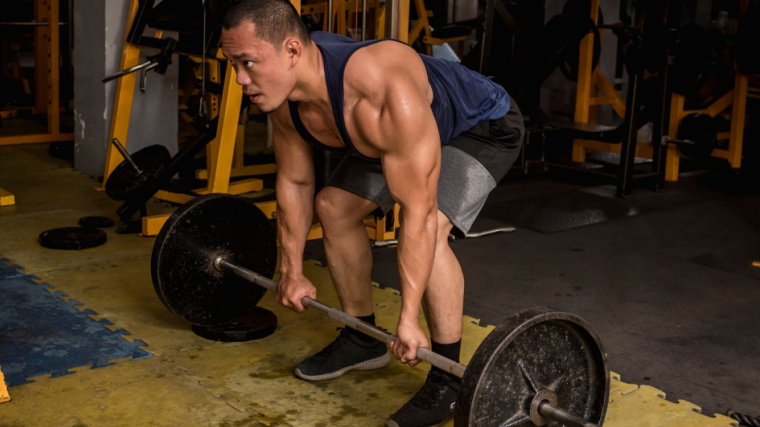
If you’re unsure about your position, or if something feels off, record a brief video or take a picture from the side for some immediate feedback. The top of your lats (back muscles) should be over the bar. Your shoulders slightly in front of the bar and higher than your hips. The bar should be close to your shins with your leg slightly bent (not in a deep squat position).
If you don’t feel tight, imagine squeezing oranges underneath your armpits. That messy but accurate visualization should help you to cue upper body tightness where it’s most needed — your upper back, shoulder blades, and shoulders.
Consider Switching to Sumo
If you notice your lower back is rounding despite setting up in an otherwise ideal position, or if you experience discomfort in your hips or spine with conventional deadlifts no matter how you adjust your setup, consider switching to a sumo stance.
No, sumo deadlifts are not “cheating.” That joke is getting old and was never that funny to begin with. There’s actually hard research showing deadlift stance comes down to your structure. (2)
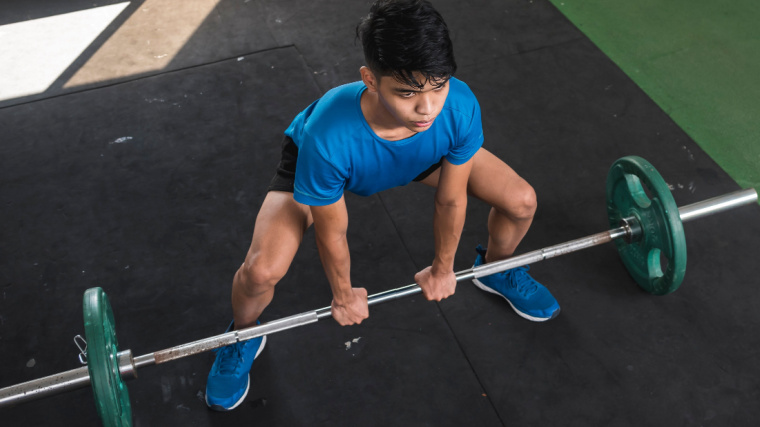
Based on your torso, femur, and tibia ratios, a sumo stance might be better suited for you. You’ll be able to build more strength with less joint strain by changing your stance. This might mean being weaker at it when you first start, though. Don’t let a short-term learning curve turn you away from a decision that’ll yield long-term results.
With sumo deadlifts, your grip should be about shoulder-width, instead of being outside of shoulder-width with conventional deadlifts. Furthermore, your stance is wider — with your feet well-outside your shoulders — with your toes slightly pointed out. How wide you go is based on your comfort, leg length, and hip mobility.
If you need to take a very wide stance, which may compromise your range of motion, you can put a weight plate under each foot to add a deficit. Other than the grip and stance being slightly different, every other lifting cue is the same as the conventional movement.
Deadlift Performance Tips
Once you’re in a good position, from your hands to your feet and everything in between, it’s time to finally get the weight off the ground. Here are some cues for the concentric (lifting) phase and the eccentric (lowering phase) of the deadlift.
Lifting the Weight
When it comes to actually lifting the weight, there are several cues you can use to ensure proper form to maximize strength and safety. Keeping you back in a neutral position should go without saying, since that’s a fundamental form tip to reduce your risk of a lower back injury.
Focus on driving through your feet and pushing your hips forward. This will help activate your quads, glutes, and hamstrings. This two-tiered approach, using your feet and hips, will let you focus on the most efficient way to produce force with good form.

If you know your way around the gym, a strong deadlift is like leg pressing the bar off the floor — you want to use a powerful, flat-footed leg drive to break the plates off the ground — followed by a hip thrust into the bar once the barbell crosses above your knees. This lets you fully recruit your glutes to finish with a strong lockout.
Exhale at the top of the rep when you’ve locked the weight, and take an all too brief moment to shift focus onto the next phase of the repetition — returning the weight to the ground.
Lowering the Weight
Most people slam the weights down quickly on the eccentric portion of the rep. This can be fine under certain conditions, but it comes from the world of powerlifting. If you are not planning to deadlift in a powerlifting competition, there is no need to do this.
Generally, you want to lower with control, not because it’s necessarily that much safer but, like any exercise, there’s still some training stimulus during the repetition when you lower with control. (3) Dropping the weight reduces the amount of work your muscles are doing and could cut into your potential results.

Lower the bar as if you were doing a Romanian deadlift, keeping the bar close to your body with your knees slightly bent. Feeling your muscles stretch as the weight approaches the ground could even contribute to some extra gains. (4) It should also keep the bar in the perfect position at the bottom for an easy transition into the next rep.
Once the weight is on the ground, let it settle for at least a split-second. Do not bounce into your next rep. It will not stimulate much tension for your muscles and, worse, could lead to injury by allowing creating momentum which prevents you from properly bracing for each repetition.
Brace, Brace, Brace
Due to it’s generally heavy nature, deadlifting performance and safety hinges on your ability to brace. (5) Pun intended. It’s important to keep your core braced from the moment you set up, hold it into lockout, and maintain a good brace as you lower the weight.
Fortunately, bracing, or keeping your core tight and stable while manipulating the weight, is relatively simple. It comes down to breathing air into your stomach rather than breathing deeply into your chest. As you take a breath in, think about expanding your abs, obliques, and lower back in 360-degrees.

If you’re wearing a lifting belt, you should feel your body expand “into” the belt. Once you feel tightness and pressure around your entire midsection, maintain that tightness as if you are expecting to get punched in the stomach. This keeps your spine in a stable position and helps to prevent your low back from rounding, which can be injurious.
There’s a subtle but crucial difference between bracing your core and simply “flexing your abs.” A braced core is solid from front to back and side to side, and promotes a safe, strong, and stable upper body. Flexed abs are simply contracted ab muscles on your midsection and can sometimes encourage a rounded torso position, which is the last thing you want during a heavy deadlift, since the abs are responsible for spinal flexion (bending your torso forward).
How to Deadlift
Here’s a concise review of how to display maximum strength and efficiency with crisp technique during the conventional deadlift.
The Deadlift Checklist
Step One — Find Your Stance
The conventional deadlift needs your feet roughly shoulder-width apart for a stable and efficient platform. If the sumo deadlift feels more comfortable, take a stance much wider than shoulder-width. In either case, get the barbell over the middle of your feet, not in front of your toes and not touching your ankles.
Step Two — Pick Your Grip
Unless you’re a competitive strength athlete, use a double-overhand grip (both palms down), with or without lifting straps depending on your need to develop grip strength. Squeeze the bar hard even if you are using straps. Keep your arms straight throughout the entire exercise.
Step Three — Brace Your Core
Start your brace before the weight leaves the ground. Maintain a 360-degree braced core throughout the entire rep, during the lifting and lowering phases. A strong brace will reinforce power transfer from your lower to upper body and help to keep your back in a neutral position.
Step Four — Lift the Barbell
Get tight before the weight even leaves the ground and stay tight throughout the entire repetition. Keep your feet flat and think about performing a leg press to drive the weight up. As the bar passes your knees, imaging doing a hip thrust to activate your glutes and lock out the weight in a standing position.
Step Five — Lower with Control
After you’ve locked out the weight, quickly refocus and lower the weight at a deliberate, not excessively slow, pace. Avoid dropping the weight without tension. The bar should end up where it began, above your midfoot. Pause briefly in the bottom to settle the weight and minimize momentum. Reset your brace and repeat the process for additional repetitions.
As They Say: Grip It and Rip It
The deadlift can initially feel awkward, especially if you don’t really know what you’re doing. Even after reading this deadlift technique lesson, it might still feel like there are so many cues to think about. But like any exercise, learn it right instead of having to learn it twice. With some practice, it will become second nature. Eventually, getting a good setup will take just a few seconds and resetting between reps will take even less than that. From there, you can build a massive deadlift and dominate the world (or just hit a PR. That’d be good, too).
References
- Kapicioglu, M., Bilgin, E., Guven, N., Pulatkan, A., & Bilsel, K. (2021). The Role of Deadlifts in Distal Biceps Brachii Tendon Ruptures: An Alternative Mechanism Described With YouTube Videos. Orthopaedic journal of sports medicine, 9(3), 2325967121991811. https://doi.org/10.1177/2325967121991811
- Cholewa, Jason M, et al. “Anthropometrical Determinants of Deadlift Variant Performance.” Journal of Sports Science & Medicine, U.S. National Library of Medicine, 1 Aug. 2019, https://www.ncbi.nlm.nih.gov/pmc/articles/PMC6683626/.
- Roig, M., O’Brien, K., Kirk, G., Murray, R., McKinnon, P., Shadgan, B., & Reid, W. D. (2009). The effects of eccentric versus concentric resistance training on muscle strength and mass in healthy adults: a systematic review with meta-analysis. British journal of sports medicine, 43(8), 556–568. https://doi.org/10.1136/bjsm.2008.051417
- Nunes, J. P., Schoenfeld, B. J., Nakamura, M., Ribeiro, A. S., Cunha, P. M., & Cyrino, E. S. (2020). Does stretch training induce muscle hypertrophy in humans? A review of the literature. Clinical physiology and functional imaging, 40(3), 148–156. https://doi.org/10.1111/cpf.12622
- Tayashiki, K., Maeo, S., Usui, S., Miyamoto, N., & Kanehisa, H. (2016). Effect of abdominal bracing training on strength and power of trunk and lower limb muscles. European journal of applied physiology, 116(9), 1703–1713. https://doi.org/10.1007/s00421-016-3424-9
Featured Image: Rocksweeper / Shutterstock

